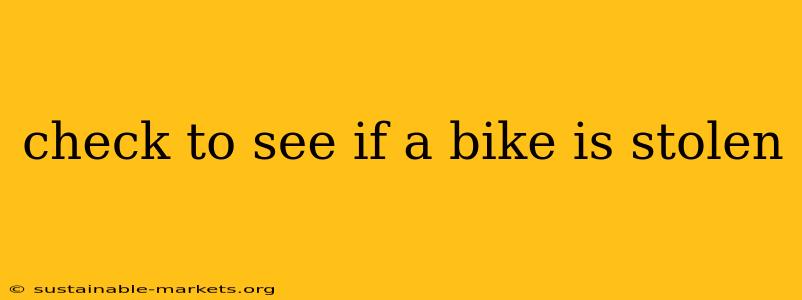Buying a used bike can be a great way to save money, but it's crucial to ensure you're not unwittingly purchasing stolen property. This guide provides a comprehensive approach to verifying a bike's legitimacy before you commit to a purchase. Ignoring these steps could lead to legal trouble and the loss of your money.
Before You Buy: Essential Checks
Before you even think about handing over cash, perform these vital checks:
1. Examine the Bike Thoroughly for Signs of Tampering
- Frame Number: This is the most important identifier. Locate the frame number (often stamped on the bottom bracket, head tube, or dropouts). Take a clear photo. Scratches, alterations, or an absence of a frame number are major red flags.
- Serial Number: Check for a serial number on components like the fork, derailleurs, or wheels. Note these down as well. Discrepancies between components can be suspicious.
- Condition: Look for inconsistencies in wear and tear. A perfectly new component on an otherwise heavily used bike could suggest replacement after theft.
- Modifications: Unusual modifications or aftermarket parts might be an attempt to disguise the bike.
2. Ask the Seller Pertinent Questions
Don't be shy! Ask detailed questions, including:
- Proof of Ownership: Request proof of purchase (receipt, registration, or similar documentation).
- Reason for Sale: A believable and consistent explanation is vital. Be wary of vague or evasive answers.
- Original Components: Ask if any parts have been replaced, and if so, why.
- Previous Owners: Inquire about the bike's history and previous owners (if applicable).
3. Utilize Online Resources to Verify the Bike
Several online resources can aid in verifying a bike's legitimacy:
- Bike Registration Databases: Many local police departments and bicycle registration services maintain databases of registered bikes. Search using the frame number. (Note: Registration isn't always mandatory and therefore might not always yield results).
- Online Classifieds and Marketplace Searches: Search online marketplaces (like Craigslist, Facebook Marketplace, etc.) for listings of bikes with similar descriptions and frame numbers. This can help identify potentially fraudulent listings.
- Social Media: Consider searching social media platforms for images of bikes matching the description or frame number. Stolen bikes are sometimes reported with photos on social media groups dedicated to bike theft prevention.
After You Buy: Further Steps to Take
Even if you've taken all the precautions, consider these post-purchase steps:
- Register Your Bike: Register your newly acquired bike with a local bicycle registry or your police department. This provides an extra layer of protection should it be stolen in the future.
- Document Your Purchase: Keep a detailed record of your purchase, including photos of the bike, the seller's information, and any proof of ownership you received. This documentation is crucial if any legal issues arise.
Red Flags to Watch Out For
These are significant indicators that a bike might be stolen:
- Unusually Low Price: A price significantly below market value for the bike's condition is a major warning sign.
- Unwillingness to Provide Proof of Ownership: A seller's reluctance to provide proof of purchase should raise serious concerns.
- Vague or Inconsistent Story: Inconsistencies in the seller's narrative about the bike's history are cause for caution.
- Damaged or Altered Frame Number: Any tampering with the frame number is a serious red flag.
By following these steps, you significantly reduce the risk of purchasing a stolen bicycle. Remember, due diligence is key to a safe and legal transaction. If something feels off, it's always better to err on the side of caution.

